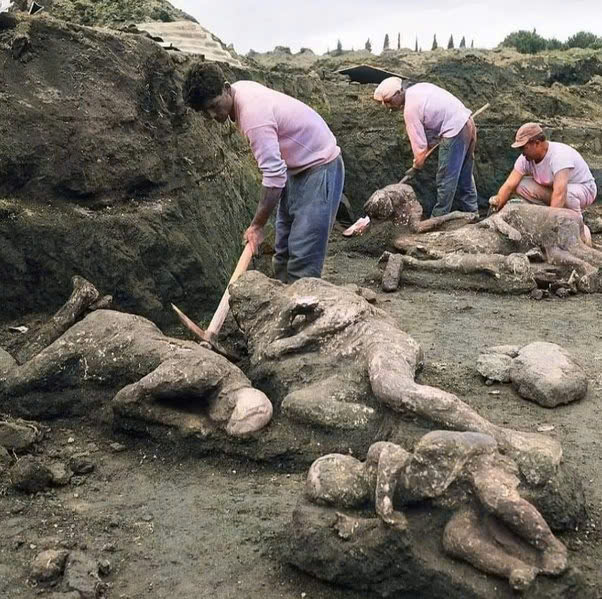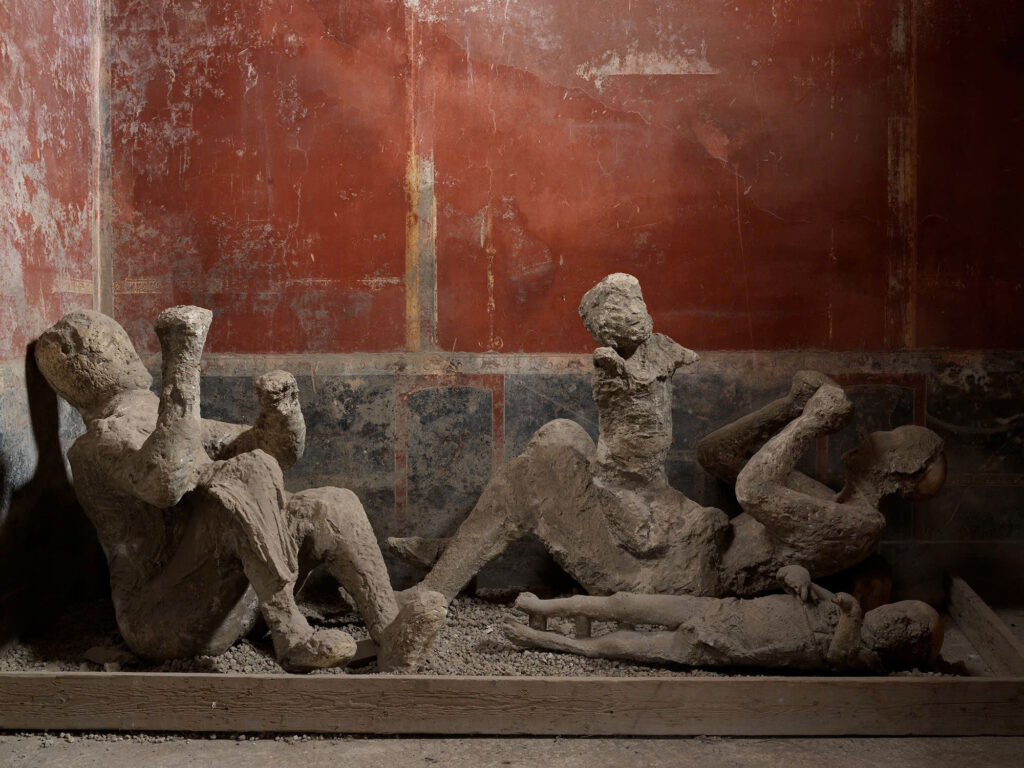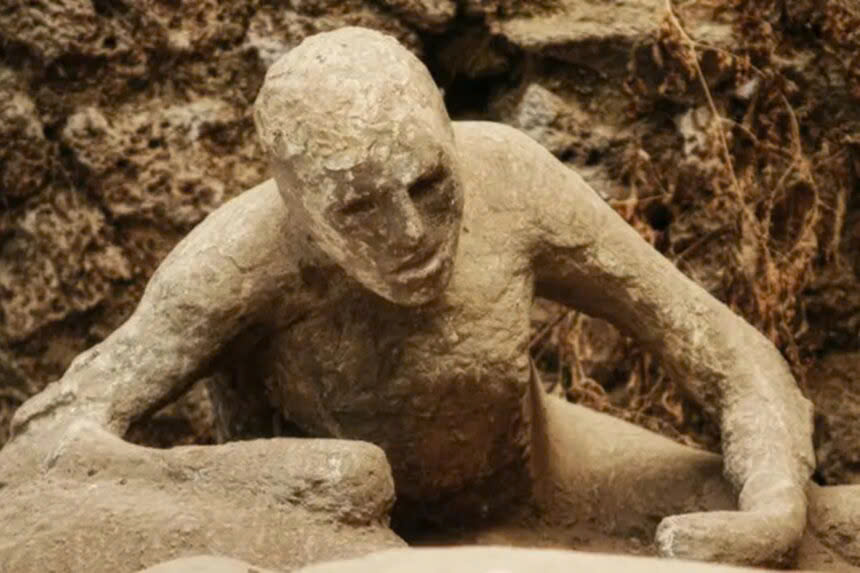In the shadow of Mount Vesuvius, Pompeii stands as one of history’s most haunting time capsules—a Roman city suspended between life and death. What began as a thriving urban center of trade, art, and pleasure became, in an instant, a monument to human fragility. The bodies of Pompeii’s residents, preserved beneath layers of volcanic ash, continue to whisper stories of a civilization silenced mid-breath.
The Fatal Day: Mount Vesuvius Erupts

In August of 79 CE, the people of Pompeii awoke to an ordinary summer morning. By nightfall, their world had ended. Without clear warning, Mount Vesuvius exploded with unimaginable force, sending molten rock, ash, and pumice high into the stratosphere. The air turned black, the earth trembled, and the midday sky darkened as though night had fallen.
Many fled toward the sea, clutching what few possessions they could carry. Others sought refuge in cellars, hoping the storm of fire and ash would pass. But as pyroclastic surges—searing waves of gas and volcanic debris—swept down the mountainside, they left no chance for survival. Within hours, Pompeii and nearby Herculaneum were entombed, sealed in silence for nearly 1,700 years.
Unearthing the Lost City

For centuries, Pompeii remained hidden beneath hardened ash and stone, forgotten by history. Then, in 1748, a group of workers digging near Naples struck remnants of painted walls and statues. Archaeologists soon realized they had uncovered one of the most astonishing archaeological sites in existence: an entire city frozen in its final moments.
As excavation expanded, streets, temples, taverns, and frescoed villas emerged intact. Everyday life—from bread still resting in ovens to graffiti scrawled on walls—was miraculously preserved. Pompeii became a window into the ordinary and extraordinary details of Roman existence: commerce, art, politics, pleasure, and faith.
The Haunting Human Remains

Among the most moving discoveries were the victims themselves—men, women, and children whose final gestures survived in the hardened ash. Their positions spoke louder than words: a mother shielding her child, a couple entwined in an embrace, a guard still at his post.
The power of these remains lies not in morbidity but in empathy. They bridge a two-thousand-year divide, reminding us that the people of Pompeii were not distant figures of history, but individuals caught in a moment of fear and hope that transcends time.
Preserving the Past: The Plaster Casts

In the 19th century, Italian archaeologist Giuseppe Fiorelli pioneered a method that forever changed our understanding of Pompeii’s victims. He noticed that decomposed bodies had left hollow spaces in the ash layers—negative molds of those who perished. By carefully pouring liquid plaster into these voids, Fiorelli created detailed casts that captured each person’s final posture, expressions, and even the folds of their garments.
The results were both scientific and deeply human. The casts revealed not skeletons, but stories—faces twisted in pain, hands clasped together, a slave chained near a doorway, a dog curled on the floor beside its master. Each figure turned tragedy into testimony.
What the Bodies Reveal

Modern analysis of the skeletal remains has provided profound insights into Roman society. Studies of bone density, teeth, and isotopic composition reveal clues about diet, disease, and class distinction. Many victims suffered from malnutrition despite Pompeii’s apparent prosperity, while others bore signs of labor-intensive lives.
Even hairstyles, jewelry, and clothing imprints on the casts have helped scholars reconstruct aspects of gender, fashion, and social hierarchy. Through them, we see a cross-section of an entire civilization—from merchants and servants to nobles and artisans—all united in the same fate.
Pompeii in the Age of Science

Recent technological advances have deepened this story. 3D imaging, DNA sequencing, and microanalysis now allow scientists to study the bodies without damaging them. In 2022, researchers successfully reconstructed the genome of one victim, offering new insights into ancient Mediterranean ancestry and health conditions.
Thermal modeling and forensic reconstruction have also confirmed that most Pompeiians died instantly from the intense heat of pyroclastic surges, not slow suffocation. The city’s preservation was, paradoxically, the result of that same catastrophe—a tragic synergy of death and conservation.
The Legacy of Pompeii
Today, millions visit Pompeii each year to walk its silent streets. The ruins are not merely archaeological relics but emotional landscapes—echoes of laughter, work, and dreams buried under disaster. The plaster casts, displayed in glass cases and open courtyards, continue to move visitors in ways few historical artifacts can.
They are reminders that nature’s fury can erase centuries in moments, yet also that memory and meaning can endure even longer than stone.
Pompeii’s story is not one of despair alone—it is also about endurance, knowledge, and the eternal human drive to understand what came before us.
Conclusion
The ancient bodies of Pompeii are not just remnants of a distant tragedy; they are reflections of ourselves—our vulnerability, our love, and our shared mortality. Through them, history ceases to be abstract. It becomes touchable, visible, heartbreakingly real.
As archaeologists continue to unearth new discoveries beneath Vesuvius’ shadow, each fragment of bone, each trace of ash, and each silent figure adds another verse to the same enduring refrain:
Time can bury, but it cannot erase.
Sources
- Smithsonian Magazine – Rediscovering the Dead of Pompeii
- BBC History – Pompeii: Life and Death in a Roman Town
- National Geographic – The Lost City of Pompeii
- Reuters – Scientists Sequence DNA of Pompeii Victims
- The Guardian – What the Bodies of Pompeii Reveal About Ancient Rome
